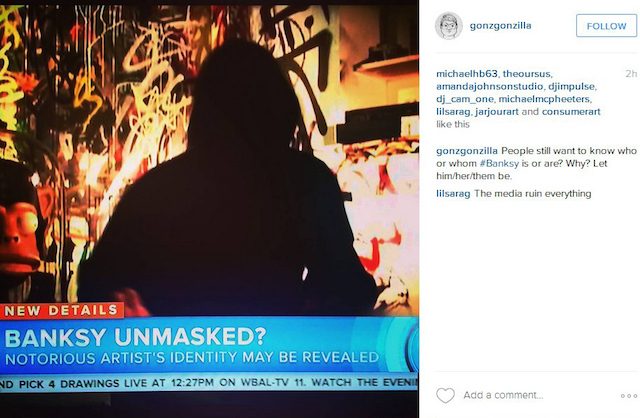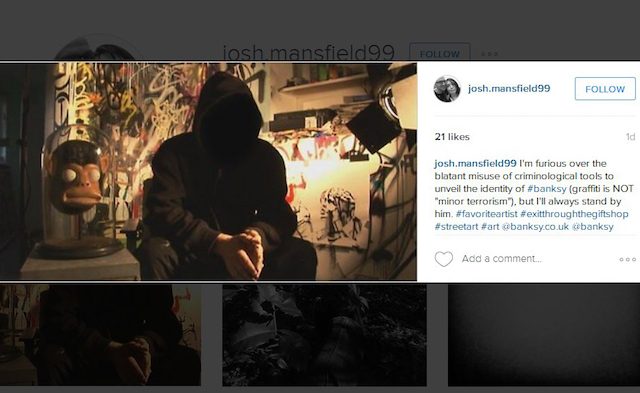
Editor’s note: This guest post is by Peter Bengtsen, one of just a handful of academics worldwide whose research focuses on street art, and I highly recommend his book The Street Art World. – RJ
Back in March 2016, Vandalog published a post that questions why anyone would want to learn the identity of Banksy. In the post, RJ Rushmore echoed the sentiments of David Choe by commenting that focusing on who the artist is “misses the point of Banksy, like watching a magic show from side stage while someone whispers in your ear how every trick is done”, and he stated that “[n]o good comes from trying to reveal Banksy’s identity, or wondering who Banksy is”. In the decade I have been studying street art academically, I have found this attitude to be very common among members of what I call the street art world, and it is one I happen to largely agree with.
The media have of course been attempting to find out who is behind the Banksy moniker for a long time. The latest attempt, published by Mail Online on 1 September 2016, suggests that the artist may be a member of a famous British music group or perhaps is a group of people working together as one persona. While media speculation about Banksy’s identity is nothing new, the avalanche in March of news stories about the ostensible uncovering of the artist’s identity – which most likely prompted David Choe to write his text – stands out because it was a result of the publication of an academic article in Journal of Spatial Science. In this article, a group of researchers presented the results of a geographic profiling study in which they had paired clusters of artworks attributed to Banksy with addresses associated with a named individual who they presented as their prime suspect for being the anonymous artist. Basically, by finding correlations between the clusters of artworks and the addresses, the researchers seemingly substantiated previous tabloid speculation about the identity of Banksy. The media, unsurprisingly, jumped on the story and repeated the name given by the researchers in the article. This was highly problematic, not only for the person being “outed” as Banksy, but also for scholars who are relying on the confidence of members of the street art world in order to do their research.
In addition to the commonsense-based critique, which has been put forward by David Choe, RJ Rushmore and many other members of the street art world, that it is simply wrong to expose an artist who has chosen to work anonymously, it is worth noting that the geographic profiling study seems to be characterised by a number of fundamental methodological flaws and ethical issues. I have described these in more detail in the freely available article Hijacking Banksy: using a contemporary art mystery to increase academic readership, but to name one example, it is a problem that the geographic profiling study focuses on just one candidate for being Banksy. With no other cases to compare their results to, the researchers openly admit in their article that it is “difficult” to make any definitive conclusions about Banksy’s identity.

Given the lack of conclusive evidence produced by the study, I find it odd (and highly ethically unsound) that the researchers are still comfortable with publishing the name of the person they have been investigating. While one of the researchers suggested on Twitter that making public the name of the suspect is not an ethical problem because the name has previously been put forward by a national English tabloid newspaper and has subsequently been repeated on thousands of websites, this line of reasoning is clearly flawed. There is, or at least there should be, a significant difference between the expectations we have for the quality of the content of tabloid press stories and academic articles.
So why would the researchers choose to include the name without solid evidence? I can only speculate, but as this segment on the news satire show Last Week Tonight with Jon Oliver points out, researchers are in sharp competition for funding, and this increasingly seems to lead to sensationalism within academia, be it in the research itself, the way it is presented to the public, or both. It is no secret that the level of international media exposure the researchers have gained by naming their suspect for being Banksy could be a factor when funding bodies are going to decide where to place their money. Playing the sensationalist card is certainly one way of getting ahead in the race for future funding (at least in the short term), even if it happens at the cost of academic integrity and at the expense of named individuals and the community of street art researchers at large.
Screenshots by Peter Bengtsen
